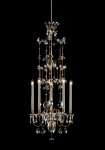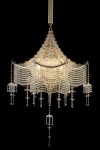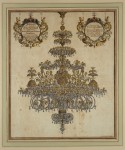Peter Rath attending at the Bellerive Museum Zurich
December 2nd 2010, 7:00 p.m.

Aleksandar Duravcevic, Chandelier, 2008; Silberstift auf Papier, 213,4 x 147,3 cm; Photo: Galerie Stefan Röpke © Galerie Stefan Röpke, Köln
This is the first exhibition on the development and the future of chandelier lighting in a public museum. Ending with a special Symposium on March 25th and 26th 2011.
Our board member, Dr. Käthe Klappenbach assisting the Curator Eva Afuhs with her team, giving us the lecture of introduction. Assistant Tanja Trampe, Jaqueline Greenspan, A. Gutknecht have put up a most clever combination of unique historic objects, mixing them with contemporary art work, to open the discussion on the future of festive lighting. It is a discussion, not on further “lamp design” it will be the discussion on “designing light” in a time of outstanding changes in light-technology and new cultural definition of “European Values”. Tomorrow, the “Kronleuchter” need not itself bring all the light required, it will be sculpture, “furnishing our architectural airspace”, again symbol and provider of mobile alternating atmosphere for any cultivated festive gathering.
The Press conference gave the opportunity to inform the public of this brave pioneer exhibition. Dr. Klappenbach together with Eva Afuhs directed a special tour.
On December 2nd, the formal opening speeches by Dr. Meier from the University, again Dr. Klappenbach and Eva Afuhs, followed by a most sensitive music performance, became exactly that eye opener that it is in museum history. Represented in the audience where sponsors, Michaela Lerch, curator of the famous Baccarat Museum in Paris, Petra Sindelar editor for glass and lighting from Northern Bohemia, myself, in charge of inventorying the Lobmeyr archives in Vienna, next year to become the “Vienna Glass-Museum”.
The entrance hall, illuminated by the newest Baccarat crystal glass-arm chandelier, dipped in blue LED-light, a disintegrating chandelier of dripping caramel by Ursula Palla, a neon installation by the US-artist Jason Roades and the “Candles burn upwards!” chandelier by Florian Ladstätter from Vienna.
The room titled “before 1800” takes us into the times of the “invention” of crystal in chandelier lighting. The natural rock crystal and it’s Swiss origin. The first glass shown with a Bohemian chandelier of 1680 or so, with the then so successful glass-arm chandelier, developed in Prussia, England, Holland, Bohemia, Spain and in Venice.
This outstanding “Ordinärer Luster” was well adaptable for transport, exported as far as South America and into the Middle East. The room shows a reproduction as made by Lobmeyr, for the Schloss-Hof castle near Vienna, also a Spanish reproduction by Ildefonso Glassworks and a modern creative homage to this glass arm form, by Petra Sindelar of Novy Bor. Also a fine Austrian chandelier in wrought iron with the typical, richly cut crystal dated before 1840, from the Lobmeyr collections.
The opposite room, titled “after 1800”, shows the important change of style from Louis XVI, Empire, Biedermeier. These are represented by a brass chandelier, originally with coloured glass bowls, by a typical “Wiener G´rüstl” originating from the Congress of Vienna 1814-15, as well as the modern use of these shapes in a hanging textile unit by Judith Seng, and a most futuristic floor chandelier with wax candles, which burning down change the shape of the bent steel wires “Etude 5”, by Atelier Oi, a wonderful example of the future system of elegant mobility in lighting.
Drawings, old Schlevogt prints and samples of crystal, light sources, electric devices in showcases help to understand the huge variety and challenges for all kinds of crafts.
On the stairway up hangs a “Lusterweibl” with antlers as used in castles since the Middle Ages, today still in touristic rustic atmosphere. Further up, a cleverly changing cylindrical chandelier by Jürgen Beg.
The main hall with video screen, showing parts of movies films that centre on action with chandeliers and then a group of very different materials used, such as paper, brass, antlers. A chandelier by architect Witzmann “Chineserhut”, my own little spiral chandelier I made for my master exam, an stag-antler piece and an egg shaped lantern.
The wonderful bathroom is lit by a lamp-work object by Susan Liebold, with cold blue light.
The room looking towards the lake, “Um 1900” shows a wonderful brilliant “lantern” by Baccarat and another clever Baccarat wall-light on mirror, giving a full, round chandelier impression. In this room also two chandeliers by the assistant to Josef Hoffmann of Vienna, Oswald Haerdtl, as executed by Lobmeyr for the 1937 Paris World Exhibition, and still existing, the original, signed design drawings.
Going round to our left, the corner room “Repräsentation der Macht” with the actual prototype that won the order for the famous chandelier groups executed by Hans Harald Rath (Lobmeyr) in 1966. Also an original scale model of one of three chandeliers for the Reichskanzlei and a box-light of 1947 from the Sophiensäle, the ballroom that was destroyed by fire recently. Photos show chandeliers of Versailles, of Herrenchiemsee, the Parliament in Bern, the Hall of Supreme Soviet in the Kremlin and just one lantern from one of the 120 chandeliers that Peter Rath designed for the Prophet’s Mosque in Medina. Eva Afuhs is represented with her “Falling chandeliers” she made for a Vienna Insurance Company.
The adjoining dark room shows off a construction by Sebastian Neitsch, where mobile arms rush up to the passer by as he comes near while the little lamp at the end comes on. Another example of the avant-garde, taking on the theme: “Light that moves”.
The next room brings examples of famous “Lichtdesign” with the chandelier by Ingo Maurer “exploding dinner set”, by Philip Stark for Baccarat in black glass, and a typical knot of bend glass sticks by René Roubicek.
The final elevator room is hardly lit by a most sensitive ceiling chandelier by the Polish artist Alicja Wasielenska. Three bushels of glass fibre lit from a strong hidden lamp are draped and broken to make a fairylike sky of stars. This is, in it’s message for me the most interesting example of what low tuned light can in future do to our halls and rooms of again cultivated festivity in Europe.
The exhibition, even with a certain lack of the most luxurious historic antiques, but most cleverly demonstrating the continuation of creative lighting, with a mix of the avant-garde can be seen as what it was meant to be: The first museum exhibition bringing the “Chandelier” away from a purely functional, often badly treated object to again be seen as one of the art objects of highest, cultural and symbolic value, as much as is the so mysterious medium light in itself.
















No Comments, Comment or Ping
Reply to “Report from the opening of the exhibition “Chandeliers Juwels of Light””